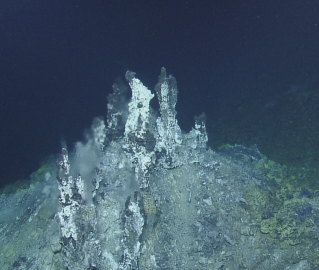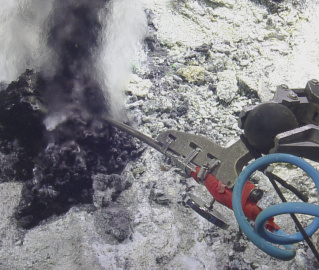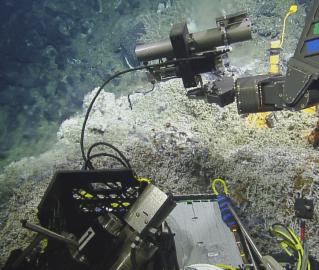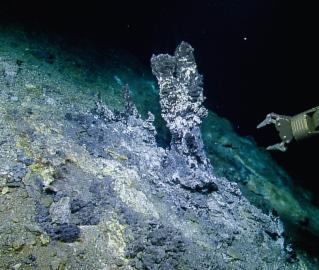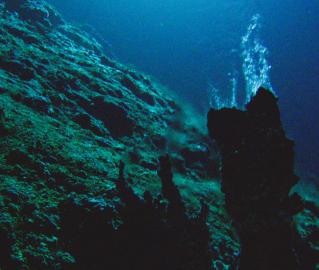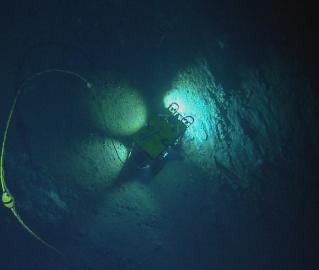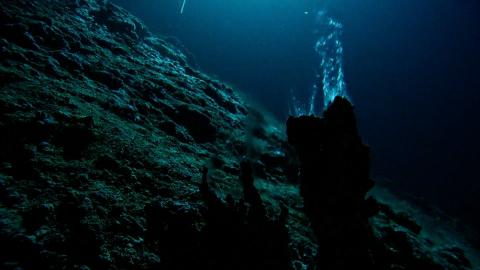Inspiration from the Unknown: Beginnings of the SUBSEA Research Program

Guest blog by Dr. Darlene Lim, Senior Scientist at NASA Ames Research Center and Co-Lead Scientist aboard E/V Nautilus for the SUBSEA Expeditions to Lō`ihi Seamount (2018) and Gorda Ridge (2019). The SUBSEA (Systematic Underwater Biogeochemical Science and Exploration Analog) Research Program is a multi-year partnership between NASA Science Mission Directorate PSTAR Program, NOAA Office of Ocean Exploration and Research, Ocean Exploration Trust, Woods Hole Oceanographic Institution, and various academic research centers.
I was asked about the inspiration for SUBSEA, and while I initially thought that the answer would be short, really, when I think about it, inspiration is truly the manifestation of many experiences over time. With each analog project I’ve been involved with, ideas on how to scope the work, what the analog would be, where we would go, and so on came from many others that I’ve had the pleasure of meeting over the years. Ideas can come at any moment; from a passing remark, a hallway conversation, a hefty article – any transmission of knowledge can inspire. So I’ll get to the answer of this SUBSEA related question in a bit, but I think it’s worth backing up a little to pull on the thread that reaches from the present to the past.
Pavilion Lake - Back in February 2004, as a newly minted NASA post-doc, I was tasked with conducting a one-off study of the limnology of Pavilion Lake. When I first went to the lake, it struck me that there was greater opportunity for science and exploration than one post-doc with a bucket and some gloves could handle. I know that this thought came from having just come away from participating in the NASA Haughton Mars Project (HMP) during grad school. At HMP, I had become familiar with the idea of using a terrestrial environment for more than just comparative planetology, but also as a place to test concepts and technologies that could shape how we send robots and humans into space. That exposure and experience helped me see Pavilion Lake through a broader lens of opportunity, and I credit the likes of Pascal Lee, Robert Zubrin and Chris McKay for seeding that vision. Chris, in particular, said to me that the service that I could provide to the community would be to help keep science in the human exploration dialog so that science requirements would be integrated into designs and ideas from the get-go. These words were indeed motivating. So, the Pavilion Lake Research Project (PLRP) was founded in August 2004, and ultimately became a decade plus long labor of love that grew into a flagship NASA analog focused on integrating science, (human and robotic) operations research, and technology development.
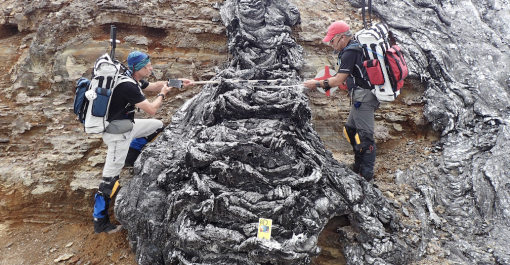
Analogs Plus Plus - When Pavilion Lake was in its final year of research activity, Jen Heldmann and I had just gotten the FINESSE research program funded and underway, and another project was being conceived – BASALT. It was funded in Spring 2015, and we are now (2019) in the final year, tying up loose ends, publishing, and passing knowledge onwards through various committee meetings, spin-off projects and the like. The inspiration for BASALT came from experiences I had with Pavilion Lake, NEEMO, DRATs, the Haughton Mars Project, and most importantly from conversations with Jen Heldmann, Steve Squyres, Scott Hughes and Andrew Abercromby. Jen, Steve and Scott had some incredible insights in connecting certain volcanic terrains on Earth to Martian processes present and past, and Steve in particular was responsible for seeding the link between Mars and the volcanic activity in Hawai`i when we were in the ideas generation phase of our project (i.e. well before it had a fancy acronym). Andrew and I had worked together for years on Pavilion Lake, NEEMO and DRATs and had many lively conversations. He was one of the visionaries responsible for how we could take a work environment focused on conducting real science and use this as a forcing function to drive out design requirements for ops concepts and capabilities that supported scientific exploration during human spaceflight. These four helped to broaden my perspective on what could be possible, what were the pressing knowledge gaps in the world of Mars exploration and human spaceflight, and where we could go on Earth that would benefit many research pathways. Undoubtedly, they too could write many blogs about the experiences they have had that shaped their ideas and inspire them today.
So how about SUBSEA? - The inspiration for this project was again founded in a web of events, encounters, articles I read, and so forth. I had the pleasure of joining the NOAA Ocean Exploration Advisory Board in 2014, and I think that I was put on this board largely because of all the stuff I wrote about earlier - i.e. science, operations and exploration experience garnered from participating in a variety of NASA analog missions. At the same time as joining this board, I was becoming more familiar with the topic of Low Latency Telerobotics (LLT). NASA was considering the application of this operational concept to a variety of human spaceflight scenarios, and as a consequence, I started learning more about the topic through my experiences at various analogs, conversations with NASA colleagues such as Andrew Abercromby, Terry Fong, Michael Gernhardt and others, and various journal papers. Furthermore, the Cassini mission and many other factors had been building strong interest in ‘Ocean Worlds’ at NASA, and exploring our Earth’s oceans as an analog to these far away systems was a hot topic. Coming back to the NOAA board, during one of our meetings, I came to learn about Telepresence – an exploration architecture that the NOAA Okeanos Explorer and the Ocean Exploration Trust's E/V Nautilus teams used to engage Scientists-on-Shore during their expeditions – as well as the data integration requirements of NOAA expeditions that seemed to mirror those of our analog projects. In terms of telepresence, this seemed like an excellent analog to LLT operational concepts, and with respect to the data synthesis requirements, this seemed like an opportunity to have NASA exploration Ground Data Systems (xGDS) software capabilities applied to Ocean Exploration.
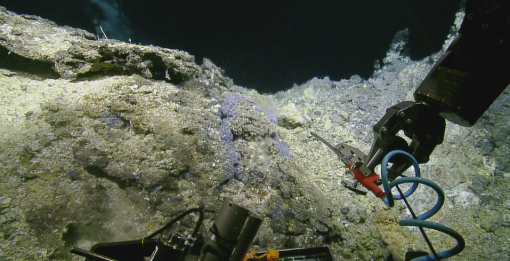
Alan Leonardi (NOAA Ocean Exploration and Research) and Brian Kennedy (formally NOAA Corps) were keen to discuss the possibilities of creating a NASA-NOAA partnership. Specifically, we discussed studying tele-presence enabled ocean exploration as an analog to LLT human spaceflight conditions and how to integrate our NASA software systems into their expeditions to study their potential for improving data synthesis and scientific decision-making for ocean scientists. Happily, the ideas were of interest to both of them, and in the summer of 2015, Alan sent a team of NOAA scientists, including Brian, to visit Pavilion Lake so that they could get a sense of our mission set up, software capabilities and discuss research partnerships. Brian Kennedy ended up being a huge part of the initial formalization efforts for SUBSEA. Brian also suggested bringing in Chris German from WHOI as the lead scientist given his background in Ocean Science and his interest in Ocean Worlds exploration. Everett Shock from ASU and Shannon Kobs Nawotniak from ISU were brought into the first iteration of the natural sciences SUBSEA team to model the energetics of the hydrothermal systems and to explore the geological landscape, respectively. They would focus on the analog possibilities of our proposed hydrothermal targets to putative vent systems and water-rock interactions on Ocean World systems such as Enceladus and Europa.
In parallel, Andrew and I proposed an Operations research pathway for SUBSEA that would examine the telepresence architecture as an analog to future LLT human spaceflight conditions. The cruises associated with first proposal were to be conducted with the Okeonos Explorer as the ship, and the Exploration Command Center (ECC) at the University of Hawai’i as one of several distributed science mission centers. The proposal also included a technology component to address the interest of supporting SUBSEA data synthesis and the integration of xGDS into NOAA ocean exploration activities. While the initial proposal submission to the NASA PSTAR program wasn’t funded, the reviews were very helpful. In particular, they identified the need for a microbiology component – an opportunity that had been missing from the first iteration. Broadly, the good news was that the panel was intrigued by the proposed ideas, thus seeding the motivation to try, try again.
Around the time that the review panel was deciding not to fund our first submission, I attended another impactful NOAA OEAB meeting at the University of Rhode Island. During this meeting, Robert Ballard, Katy Croff Bell, Nicole Raineault, Allison Fundis, and others provided an impressive overview of the Ocean Exploration Trust (OET), E/V Nautilus and Inner Space Center (ISC) telepresence architecture among other topics. Their professionalism, focus on metrics, and organized attention to detail were among many related elements that stood out in their presentations, and that were, for me, compelling reasons to form a partnership with OET. As well, Chris German and Zara Mirmalek (Harvard University) gave a presentation on how they had recently utilized the OET telepresence architecture to conduct an NSF-funded expedition. The ethnographic research that Zara had conducted was particularly compelling; it was unlike anything that I had seen included in an analog study to date and seemed like a particularly innovative research pathway by which to learn about decision-making intricacies, systems design, and human-robotic interactions. Happily, after a few meetings and separate field outings, Zara agreed to participate in the second proposal iteration as one of two Operations Research leads. The second Ops Lead would be Matthew Miller (NASA JSC), a cognitive systems engineer who I had the pleasure of working with during the Pavilion Lake Research Project and then again with on BASALT. Together, Zara and Matthew would scope the innovative Operations Research component of the second SUBSEA proposal.
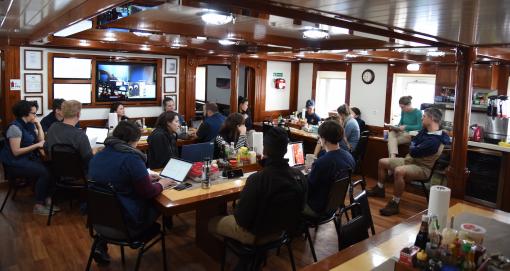
A few events led to the eventual partnership of SUBSEA with OET on the second proposal submission, including the move of the Okeanos Explorer to the Atlantic and the presence of the E/V Nautilus in the Pacific where the science targets of interest were located for the SUBSEA natural sciences team. Ultimately, the second proposal was submitted in 2016. This proposal included the addition of Julie Huber’s (WHOI) microbiology objectives, Chip Brier’s engineering expertise, Zara and Matthew’s ethnographic and cognitive systems engineering research elements, and updates to the telepresence architecture with the team being co-located at the Inner Space Center at the University of Rhode Island during each of the two proposed cruises. Together, the personnel additions and operational updates greatly strengthened the proposal offering for the reviewers, and SUBSEA was selected for funding by the NASA PSTAR program in 2017.
Last thought - Every inspiration, including that for SUBSEA, stems from a journey that includes a network of individuals and teams all of whom can bring ideas, experiences, and energy to the table. It takes a village to explore the unknown and to push the limits of our knowledge, and it’s fun to think about the links that SUBSEA will have to future, unknown research, and how it might impact careers and professional choices of many that are involved with this project. Fingers crossed that we are adding some more good stuff to a foundation that will propel others into a future of science, exploration and adventure.
Learn more about the 2019 SUBSEA expedition aboard E/V Nautilus and more about the research of Dr. Darlene Lim.
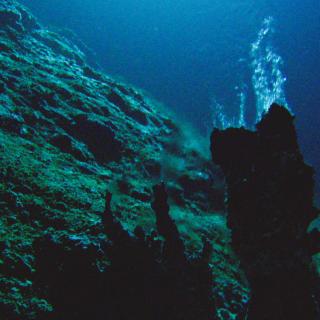
Gorda Ridge
This expedition continues the multi-year SUBSEA (Systematic Underwater Biogeochemical Science and Exploration Analog) Research Program, a partnership between NASA, NOAA, and various academic research centers. Bringing together both ocean and space exploration teams aboard E/V Nautilus, SUBSEA blends ocean exploration with ocean worlds research to address knowledge gaps related to the exploration of our Solar System.
